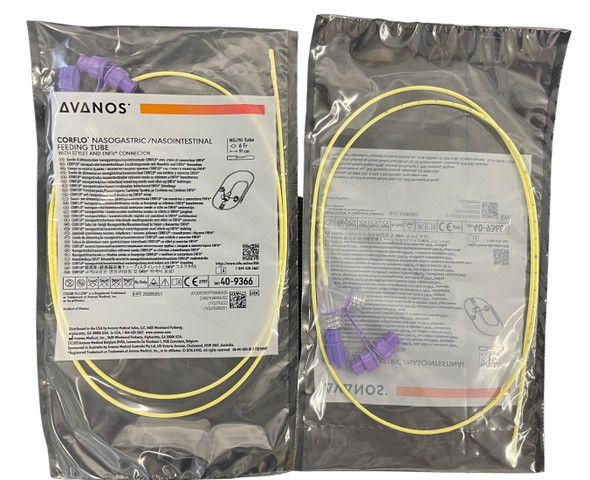Description
Product Information
CORFLO* Nasogastric/Nasointestinal Feeding Tube is uniquely designed for delivering enteral nutrition. Each package comes with a variety of features that provide consistent performance and convenience, including an anti-clog bolus, centimeter markings, and a water activated lubricated tip and internal lumen.Multiple Choices for Clinician ConvenienceWith multiple packages from which to choose, clinicians can choose whether or not they want ENFit, Universal, and Anti-IV proximal connectors. Similarly, our polyurethane CORFLO* NG/NI tubes are available in various lengths and French sizes. Avanos Medical, a leader in the enteral feeding market, offers a wide variety of innovative, high-quality enteral feeding tubes and accessories designed for delivering enteral nutrition.
Product Features
- Weighted/Non-Weighted
- With and without stylet
- ENFit, Universal, and Anti-IV proximal connectors
- Anti-clog bolus
- CM Markings
- MRI conditional once stylet is removed
- Flow-Through Stylet
- Radiopaque
- Water Activated Lubricated Tip & Internal Lumen (stylet tubes only)
Link To Other Sizes and Models
| Avanos Corflo Nasogastric/Nasointestinal Feeding Tube | |||||
| Anti-Clog With Enfit Connector | Anti-Clog With Enfit Connector Smooth Shape Bolus | With Stylet Anti-Clog Pill Shaped Bolus With Enfit Connector | Controllers With Enfit Connector | Controller With Enfit Connector Smooth Shape Bolus | Controller With Enfit Connector Pill Shape Bolus |
| 5Fr | 6Fr | 8Fr, 10Fr | 8Fr, 10Fr, 12Fr | 8Fr, 10Fr | 8Fr, 10Fr |
| 6Fr | 8Fr | ||||
| 8Fr | 10Fr | ||||
| 10Fr | 12Fr | ||||
| 12Fr | |||||
Product Specifications
Diameter (Fr) | 5 |
Catheter Length (In.) | 22 |
Tube Length (cm) | 109 |
Tube Length Color Code | Blue |
Primary Product Color | Yellow |
Product Brand | CORFLO |
Product Characteristics
What MRI safety information does the labeling contain? | MR Conditional |
Device required to be labeled as containing natural rubber latex or dry natural rubber (21 CFR 801.437): | No |
Device labeled as ""Not made with natural rubber latex"": | No |
For Single-Use: | Yes |
Prescription Use (Rx): | No |
Over the Counter (OTC): | No |
Kit: | No |
Combination Product: | No |
Human Cell, Tissue or Cellular or Tissue-Based Product (HCT/P): | No |
FAQ
Corflo is a type of feeding tube that is used for providing nutrition to patients who cannot eat or swallow normally. It is a nasogastric tube, which means it is inserted through the nose, down the esophagus, and into the stomach. The tube is usually used for short-term feeding or as a temporary measure until the patient is able to eat or swallow normally again.
A Corflo feeding tube and a Mickey button are both types of enteral feeding tubes, which are used for providing nutrition to patients who are unable to eat or swallow normally. However, there are some key differences between the two types of tubes:
- Insertion site: A Corflo feeding tube is a nasogastric tube that is inserted through the nose, while a Mickey button is a type of percutaneous endoscopic gastrostomy (PEG) tube that is inserted through the abdominal wall directly into the stomach
- Durability: Mickey buttons are designed to be permanent and are often used for long-term feeding, while Corflo feeding tubes are typically used for short-term feeding and are easily removed when no longer needed.
- Maintenance: Mickey buttons require regular care and cleaning, as well as replacement of the external button portion every three to six months, while Corflo feeding tubes are typically replaced every five to seven days.
In summary, the choice between a Corflo feeding tube and a Mickey button will depend on the individual needs of the patient, including the duration of feeding required, the patient's ability to care for the tube, and other factors.
Corflo nasogastric (NG) tubes are typically used for short-term feeding, and are meant to be removed and replaced every 5 to 7 days. The exact length of time that a Corflo NG tube can remain in place will depend on several factors, including the patient's overall health, the type of formula being administered, and any potential complications.
It is important to regularly assess and monitor the patient's condition and replace the tube as needed to minimize the risk of infection or other complications. The healthcare provider responsible for the patient will determine the appropriate duration for the use of a Corflo NG tube and will make recommendations for replacement or removal.
A nasogastric (NG) tube is a type of feeding tube that is used to provide nutrition to patients who are unable to eat or swallow normally. It is inserted through the nose, down the esophagus, and into the stomach. NG tubes are commonly used for a variety of purposes, including:
- Short-term feeding: When a patient is unable to eat or swallow normally due to illness, injury, or other medical conditions, an NG tube can be used to provide nutrition until the patient is able to eat or swallow normally again.
- Decompression of the stomach: An NG tube can be used to relieve pressure or discomfort in the stomach caused by conditions such as abdominal distension, bloating, or nausea.
- Administration of medication: An NG tube can be used to administer medication directly into the stomach, bypassing the need for oral consumption.
- Diagnostic purposes: An NG tube can be used to obtain samples of stomach contents for diagnostic purposes, such as to diagnose conditions like gastric reflux or to test for the presence of harmful substances.
The use of an NG tube is typically a temporary measure, and the tube is removed as soon as it is no longer needed. It is important to regularly monitor and assess the patient's condition while using an NG tube to minimize the risk of complications.














